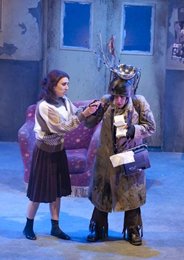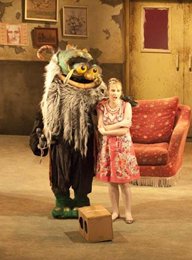The performance of this new opera begins with the procession of the Brian Irvine Ensemble into the orchestra pit where Irvine conducts them, and the audience, in the overture. The musicians play as they walk, creating an image of street performers or minstrels which sets the playful mood for the work; the fact that some of them are masked hints at the strange nature of the Dumbworld’s fictional universe. Irvine is well known for his creative combination of elements from different musical genres, producing work which manages to be startling or discordant without being difficult to listen to. In Postcards from Dumbworld the music combines jazz, classical, electronica and pop to create a work that is far removed most people’s expectations of opera.
 Postcards from Dumbworld was originally commissioned by Opera Fringe and the Wexford Opera Festival, and is a collaboration between composer Brian Irvine and filmmaker John McIlduff. McIlduff’s libretto is a story in seventeen loosely connected scenes, as the characters struggle with their various insecurities and search for love. The title says it all: these scenes are postcards, fragments from this absurd reflection of human life. The characters include Shirley the bingo caller, her son Morris whose ‘to do’ lists include “only one wank a day”, Eddie who believes he is an undercover KGB agent and Shane who has his own monster. The first act has seven scenes that introduce the characters, and the second act develops their stories and provides a temporary resolution for each.
Postcards from Dumbworld was originally commissioned by Opera Fringe and the Wexford Opera Festival, and is a collaboration between composer Brian Irvine and filmmaker John McIlduff. McIlduff’s libretto is a story in seventeen loosely connected scenes, as the characters struggle with their various insecurities and search for love. The title says it all: these scenes are postcards, fragments from this absurd reflection of human life. The characters include Shirley the bingo caller, her son Morris whose ‘to do’ lists include “only one wank a day”, Eddie who believes he is an undercover KGB agent and Shane who has his own monster. The first act has seven scenes that introduce the characters, and the second act develops their stories and provides a temporary resolution for each.
The design is quirky and supports the overall aesthetic of the show. Kennedy’s sound design is excellent and works seamlessly with the music. The set and costumes create the look of a children’s dressing-up box, with Eddie’s spy costume built of old goggles, a trench coat, and a helmet with a tin-can radio receiver on the top. Shane’s monster, when it appears, resembles the Gruffalo with its furry body and big tusks and comically large head, and the KGB agents in their dark glasses and tightly belted trench coats are reminiscent of vintage Spy versus Spy comics. This appeal to an eclectic range of cultural reference points mirrors the style of the music, and heightens the sense that this fictional world is one created by each character in turn and that each scene is an almost expressionistic glimpse inside their heads. The single, simple set is transformed in each of these scenes into the threatening streetscape of Eddie’s paranoid imagination, the squalor of Morris’s flat or the frustrated chaos of the bedroom where Shane and Monika try and fail to build their flat-pack bed. The ‘Bingo’ sign that remains up throughout connects the random events that befall the characters in their various searches for love and fulfilment to the banal, chance nature of bingo: some win, and some lose.
The work is inventive and often excellent in its individual elements. There are very strong performances by the Ensemble and the soloists, and the penultimate scene, which is sung by the cast and three choirs, is moving and uplifting. But somehow the work is less than the sum of its parts. There are minor problems, such as the  difficulty in reading the intertitles that announce the scenes, and a slight physical awkwardness on the part of some performers when they are on stage but not immediately involved with the action. Irvine’s addresses to the audience, which work well in his Ensemble’s performances, do not work in the same way in the context of the opera where they interrupt the spectator’s engagement with the other world in process on the stage.
difficulty in reading the intertitles that announce the scenes, and a slight physical awkwardness on the part of some performers when they are on stage but not immediately involved with the action. Irvine’s addresses to the audience, which work well in his Ensemble’s performances, do not work in the same way in the context of the opera where they interrupt the spectator’s engagement with the other world in process on the stage.
However, the main problem is with the structure of the narrative, not helped by the fact that the words of the libretto were often obscured by the music. This seems of more consequence in this work than in classical opera, because the focus of the narrative is so much on individual characters rather than on a grand narrative arc. The plot – which is associational and episodic rather than linear – is too loose in the first act; it is not compelling because it is little more than a series of introductions.
There are many beautiful moments. The shadow puppet story of Peter, Lily and the Nose is charming and its moral is well-placed within the overall narrative; the KGB agents emerging from a skip to threatening chords is funny and clever; and there is a highly visual representation of Eddie and Sally falling in love. Perhaps it is for this reason that the flaws are so visible. Nonetheless, Postcards from Dumbworld is an interesting production by this new collaborative team, who are already hinting at more extraordinary projects to come.
Lisa Fitzpatrick lectures in Drama at the University of Ulster.